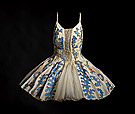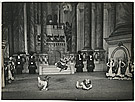Le Mariage d'Aurore [Aurora's Wedding]
Ballet in one act
- Producer: Les Ballets Russes de Serge Diaghilev
- Premiere: 18 May 1922, Théâtre national de l’Opéra, Paris
- Costume design: Alexandre Benois (from Le Pavillon d’Armide) with new costumes by Natalia Goncharova
- Costumier: Ivan Caffi (Imperial Theatres, St Petersburg) for re-used costumes from Le Pavillon d’Armide
- Scenery design: Alexandre Benois (from Le Pavillon d’Armide)
- Music: Pyotr Il’yich Tchaikovsky, partly re-orchestrated by Igor Stravinsky
- Choreography: after Marius Petipa
- Libretto: Marius Petipa and I Vsevolozhsky, after Charles Perreault’s fairytale
- Main characters: Princess Aurora, Prince Florestan, Shéhérazade, Bluebird, Little Red Riding Hood, Blue Beard, Buffoons, Ivan and his brothers
This ballet confines itself to the final part of the ballet Sleeping beauty, the marriage feast of Aurora and her prince. It consists of a series of novelty character dances performed by the wedding guests, among which are nobles, a retinue of fairies (from the earlier production of The sleeping princess), the Bluebird and Little Red Riding Hood, who join the awakened Princess Aurora dancing with her new groom Prince Florestan in an enchanted setting.
After the financial failure of The sleeping princess, Diaghilev returned to Paris in very reduced circumstances, unable to bring the production to the city as he had planned. With little money to create entirely new works, but with a loyal cohort of experienced dancers looking to him for employment, he decided to stage the final act of The sleeping princess as Le Mariage d’Aurore using the music score that he had retained. He decided to re-use a mélange of costumes from his stock, including a number of key eighteenth-century style outfits from his 1909 production of Le Pavillon d’Armide. Premiered with the new work, Le Renard (The fox), developed by Stravinsky and designed by Larionov, Le Mariage d’Aurore proved to be a popular, if artistically compromised, production that would remain in the repertoire of Diaghilev’s Ballets Russes successors during the 1930s.






